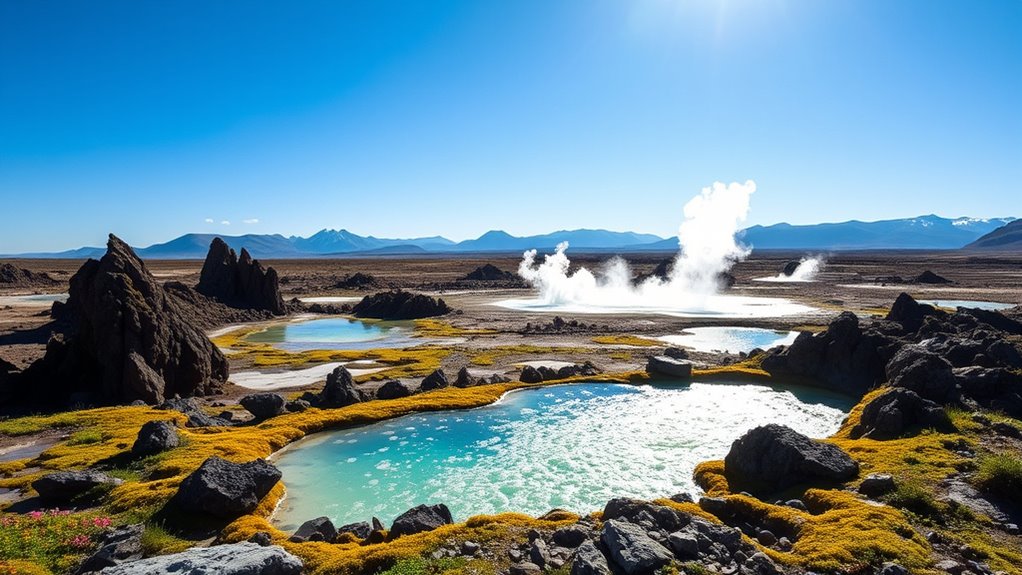Geothermal energy's harnessing the Earth's heat, making it a sustainable power source for electricity generation and direct use applications like heating and agriculture. You'll find various systems, including flash steam, dry steam, and binary cycle plants, each with its unique advantages. While it offers low emissions and reliability, there are challenges like resource management and logistical issues. Explore how geothermal energy can benefit you further as you discover its applications and innovations.
Key Takeaways
- Geothermal energy is a renewable resource derived from the Earth's internal heat, utilized for electricity generation and direct heating applications.
- Various geothermal systems include flash steam, dry steam, binary cycle, and geothermal heat pumps, each serving distinct energy generation or heating purposes.
- The benefits of geothermal energy include low carbon emissions, reliable baseload power, job creation, and integration possibilities with other renewable sources.
- Risks associated with geothermal energy involve potential earthquakes, resource depletion, and environmental impacts if not properly managed.
- Financial planning and technological advancements, such as AI analytics, are crucial for improving efficiency and attracting investments in geothermal projects.
Definition and Origin of Geothermal Energy
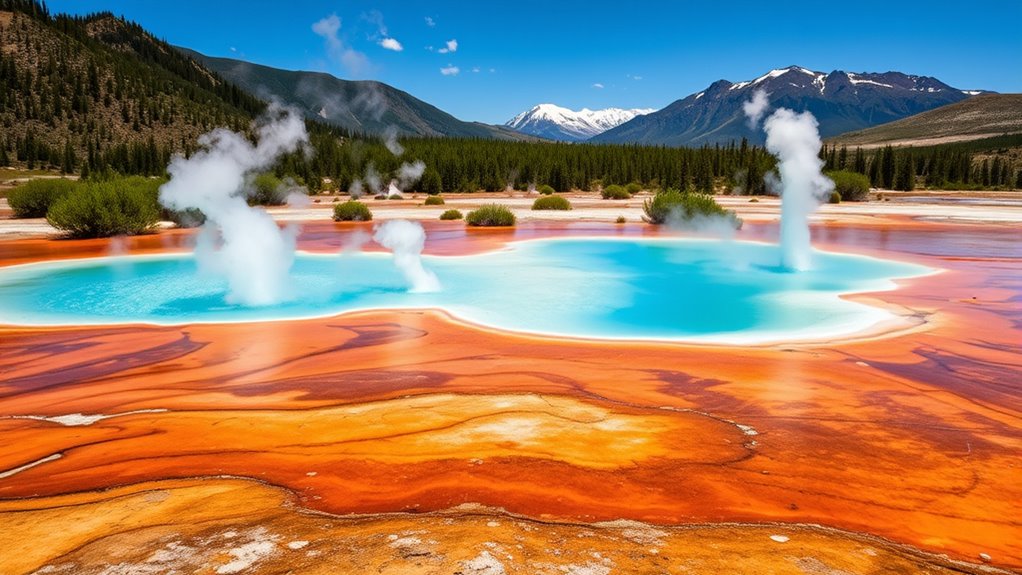
Geothermal energy, derived from the Greek words "geo" (earth) and "thermos" (hot), refers to the thermal energy stored within the Earth. This energy comes from the heat generated during the planet's formation and the decay of radioactive elements. Because of its continuous heat production, geothermal energy is considered a renewable resource. You might be surprised to learn that people have harnessed this energy for thousands of years, initially using it for heating and bathing. In fact, the earliest known use dates back to the Paleolithic era. Today, you'll find geothermal energy applied globally for both power generation and heating, expanding significantly since the establishment of the first geothermal power plant in Larderello, Italy, in 1913. Additionally, innovations in geothermal technology have enhanced its efficiency and reduced environmental impact, aligning with sustainable energy practices. Countries like Iceland and the USA lead in geothermal energy production, showcasing its diverse applications and benefits.
Types of Geothermal Systems
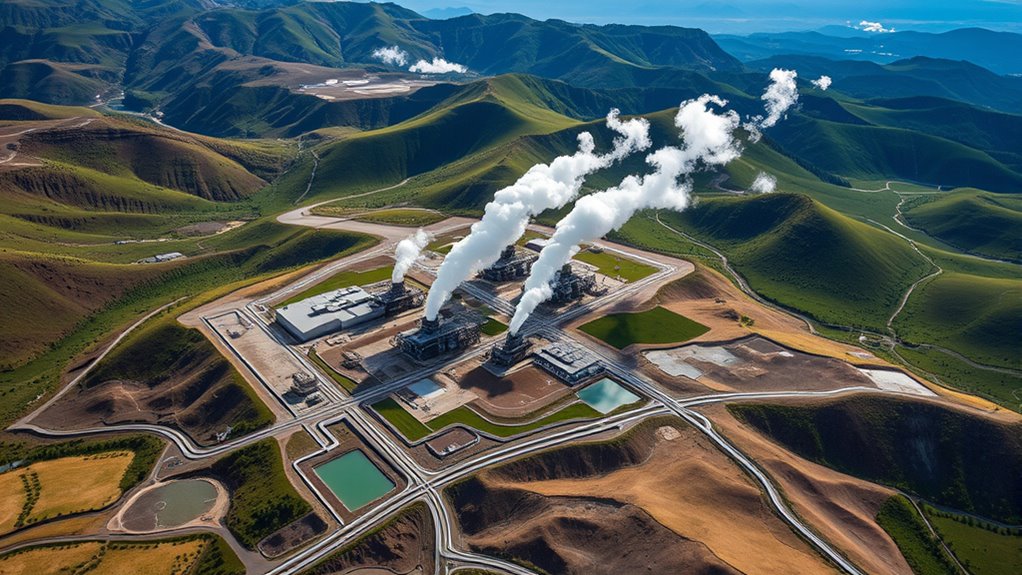
While exploring the various types of geothermal systems, you'll find that each method harnesses the Earth's heat in unique ways.
Flash steam power plants are the most common, using high-pressure water that flashes into steam to drive turbines. Dry steam power plants directly utilize naturally occurring steam, while binary cycle power plants use a secondary fluid to vaporize and generate energy.
Flash steam power plants dominate the field by converting high-pressure water into steam, while dry steam and binary cycle plants utilize steam and secondary fluids, respectively.
You might also encounter hybrid geothermal power plants that combine these technologies for optimal output.
For direct use, geothermal systems heat buildings, support greenhouse agriculture, and warm water for pools. Geothermal heat pumps, in closed or open-loop systems, offer efficient heating solutions. Heat pump efficiency can be significantly influenced by ambient temperature and proper installation.
Enhanced geothermal systems aim to extract heat from hot rock formations, presenting exciting future potential.
Applications of Geothermal Energy
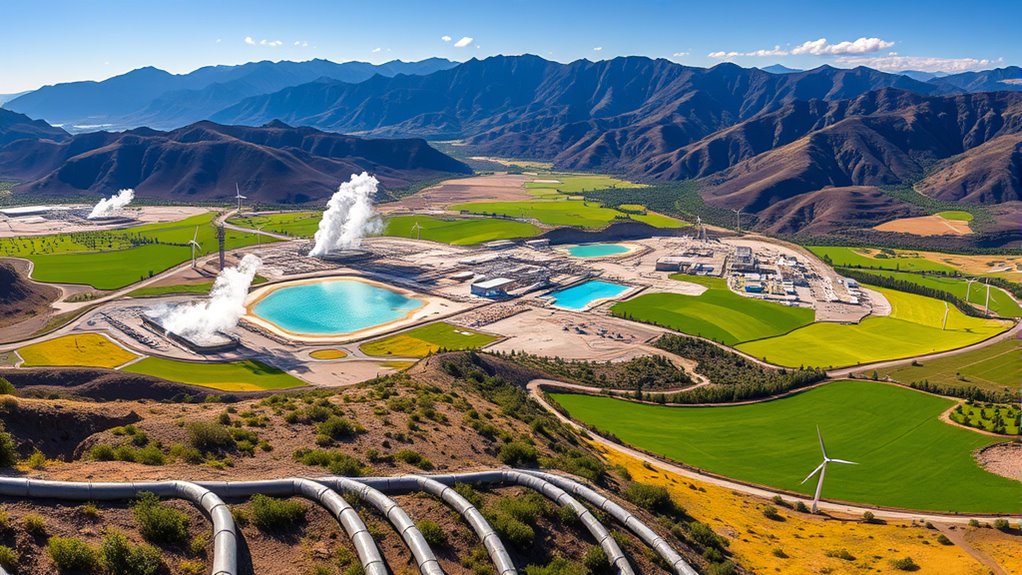
Numerous applications of geothermal energy showcase its versatility and efficiency across various sectors.
You can see geothermal energy in electricity generation, particularly in volcanic regions like the Pacific Ring of Fire, where high-temperature resources power plants. High refresh rates in geothermal power generation systems can enhance overall efficiency.
Direct use applications involve heating buildings, greenhouses, and swimming pools without generating electricity. The use of geothermal energy for crop yields can significantly improve agricultural productivity and sustainability. Additionally, portable camping toilets can benefit from geothermal heating systems in remote areas, providing comfort and convenience for campers.
Ground source heat pumps offer efficient heating and cooling, cutting energy consumption by up to 50%.
In agriculture and aquaculture, geothermal heat enhances crop yields and supports fish cultivation.
Lastly, tourism thrives on geothermal hot springs, providing relaxation and therapeutic benefits, while industries leverage geothermal energy for processes like cement curing and biofuel production, enhancing efficiency and reducing environmental impact. Additionally, backyard greenhouses benefit from geothermal energy, allowing for an extended growing season and improved plant health.
Benefits of Geothermal Energy
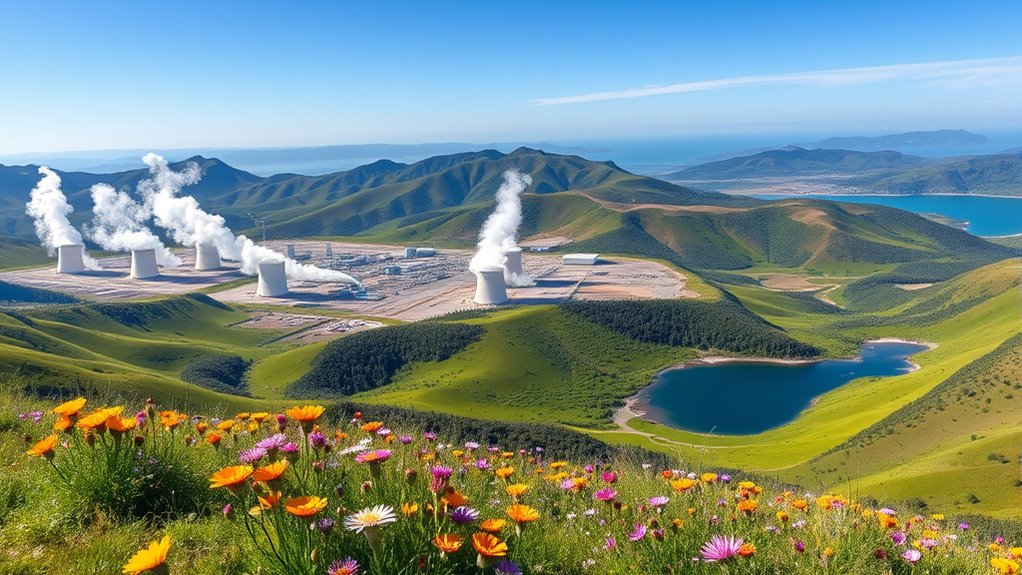
The numerous applications of geothermal energy highlight its diverse benefits across various sectors.
You'll appreciate its low carbon footprint, releasing 99% less CO2 than fossil fuels. As a renewable source, geothermal energy harnesses heat from the Earth's core, ensuring sustainability. Additionally, smart toilets exemplify how advanced technology can enhance environmental sustainability in everyday life. Moreover, the rise of sustainable fashion emphasizes the need for eco-friendly solutions like geothermal energy. Geothermal energy systems can leverage high efficiency ratings, offering significant savings on energy consumption. Furthermore, the use of meal replacement juices for weight loss can complement geothermal energy initiatives by promoting healthier lifestyles.
With minimal pollution and a small land footprint, it preserves natural habitats while providing reliable power. Geothermal plants operate continuously, making them dependable for baseload energy demands.
Economically, they create jobs, stimulate local economies, and offer long-term savings, especially with geothermal heat pumps.
With high energy efficiency and versatile applications, you'll find geothermal systems significantly reduce energy consumption.
Plus, they enhance energy security, ensuring a cleaner, safer future for your community and beyond. Additionally, geothermal systems can be integrated with solar panels with battery storage, maximizing energy independence and reliability.
Technologies and Developments
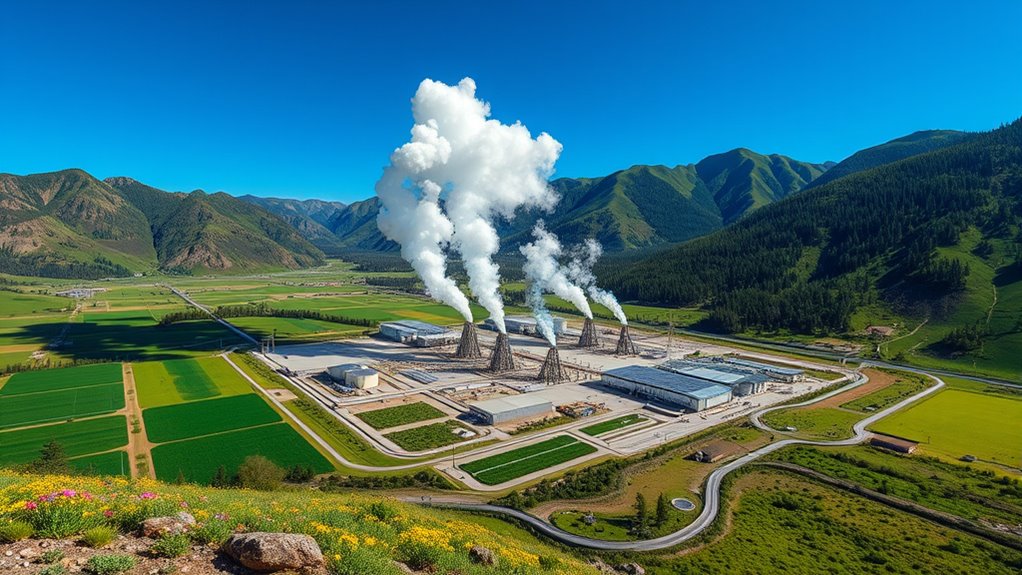
As geothermal energy continues to evolve, innovative technologies and developments are paving the way for a more sustainable future. Enhanced Geothermal Systems (EGS) utilize hydraulic fracturing to tap into geothermal resources in unconventional areas, creating efficient pathways for heat extraction. Additionally, heat pumps can be integrated into geothermal systems to further enhance energy efficiency and provide both heating and cooling capabilities. Regular maintenance of these heat pump systems is essential for maximizing their performance and lifespan. The integration of AI tools for real-time performance tracking can also significantly optimize the efficiency of geothermal energy systems.
Companies like Fervo Energy are pioneering underground "batteries" to store and release energy. Advanced Geothermal Systems (AGS) employ closed-loop systems, expanding geothermal's reach even in regions without hydrothermal activity.
Geothermal heat pumps leverage shallow ground temperatures for efficient heating and cooling in homes. Next-generation technologies could provide up to 120 gigawatts of capacity by 2050, ensuring reliable, weather-independent electricity. Additionally, integrating geothermal systems with battery-less solar inverters can enhance energy efficiency by utilizing energy as it's produced.
Projects like Utah FORGE and collaborations are crucial for advancing these promising developments.
Challenges and Future Prospects
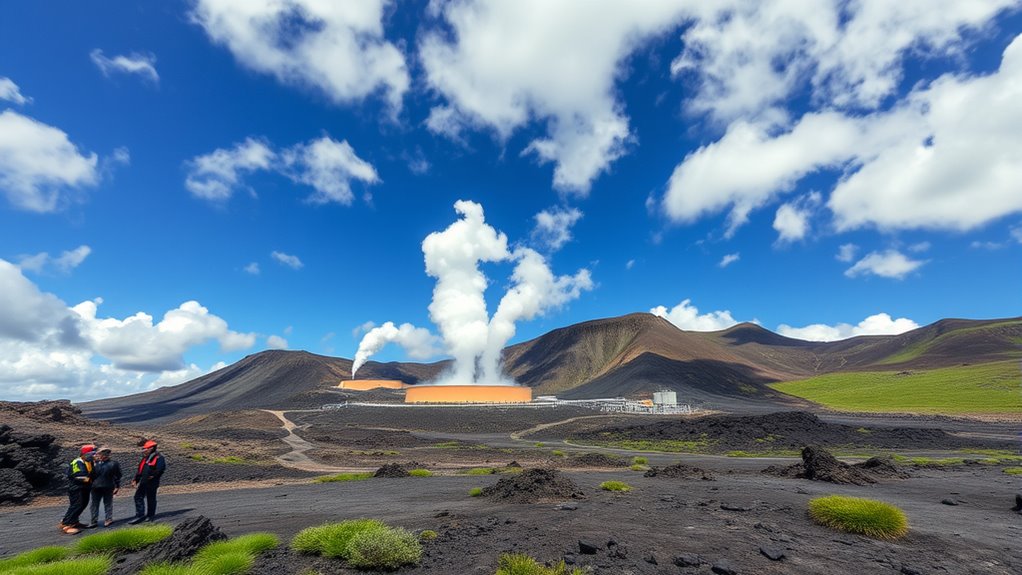
While geothermal energy presents significant potential for sustainable power generation, it also faces a variety of challenges that could hinder its growth.
You'll find that geographical limitations restrict geothermal development to tectonically active regions, which often come with risks such as earthquakes and volcanic activity. Only a small fraction of the Earth's surface has accessible hydrothermal resources, and improper management can lead to resource depletion. Additionally, understanding the importance of long-term financial planning for geothermal projects can encourage investment in this renewable energy source. Moreover, energy-efficient heat pumps can be integrated into geothermal systems to enhance overall efficiency and reduce operational costs. AI-enhanced predictive analytics can also help in monitoring geothermal systems for better resource management. Furthermore, the potential for diversification benefits through integrating geothermal energy with other renewable sources could also attract more investors.
Additionally, there are concerns about seismic activity, groundwater impacts, and emissions during operation, which can affect local ecosystems.
Access to transmission lines also poses logistical issues, making it tough to transport power from remote geothermal sites. Addressing these challenges is crucial for realizing geothermal energy's full potential in the future, and implementing regular training on fire safety can help mitigate operational risks associated with geothermal facilities.
Frequently Asked Questions
How Does Geothermal Energy Compare to Solar and Wind Energy?
When you compare geothermal energy to solar and wind, you'll notice geothermal offers consistent baseload power, while solar and wind are intermittent and reliant on weather.
Geothermal's capacity factor often exceeds 90%, making it a stable choice. Although geothermal projects have high upfront costs, they maintain low operating expenses.
In contrast, solar and wind have seen decreasing installation costs but generally require more land and have higher variability in energy production.
What Are the Geographical Limitations for Geothermal Energy Use?
Imagine trying to harvest energy from the sun in a cave—geothermal energy faces its own geographical challenges.
You've got to find areas with suitable geothermal reservoirs, often near tectonic plate boundaries or volcanoes. These spots are limited and can be remote, lacking infrastructure.
Plus, high seismic activity can complicate plant construction. Without the right temperature and steam availability, harnessing geothermal power becomes a daunting task, making it less accessible than you'd hope.
Can Geothermal Energy Be Used in Residential Homes?
Yes, you can definitely use geothermal energy in residential homes.
These systems take advantage of the constant temperature underground to provide efficient heating and cooling. By installing ground loops and a heat pump, you'll enjoy significant energy savings and minimize your environmental impact.
While the initial costs can be high, the long-term savings on utility bills often make it a worthwhile investment. Plus, many incentives can help offset those upfront expenses.
How Long Does It Take to Install Geothermal Heat Pumps?
"Good things come to those who wait." When you're looking to install a geothermal heat pump, expect the process to take a bit of time.
Planning can take up to two weeks, while the actual installation usually ranges from one to three days, depending on the system type.
Factors like soil conditions and site design play crucial roles, so patience is key as you prepare for a more energy-efficient home.
Are There Government Incentives for Geothermal Energy Projects?
Yes, there are government incentives for geothermal energy projects.
You can take advantage of the federal tax credit, which offers a 30% deduction for residential geothermal systems effective from January 1, 2023, until 2032.
If your project is commercial and under 1 megawatt, you'll also qualify for the same credit.
Various programs, including the GeoVision project, support geothermal development, making it an attractive option for sustainable energy investment.
Conclusion
In harnessing geothermal energy, you tap into the Earth's heat, transforming it into power, warmth, and sustainability. You can reduce your carbon footprint, boost energy independence, and embrace a cleaner future. By investing in geothermal technology, you're not just accessing energy; you're igniting innovation, fueling progress, and fostering resilience. As you explore these endless possibilities, remember: every step toward geothermal energy is a step toward a greener, brighter world for generations to come.
